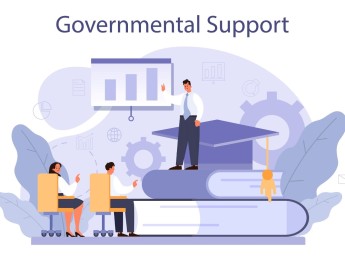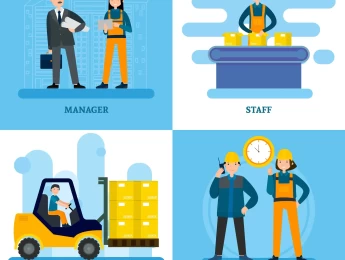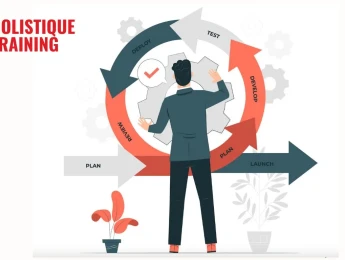- Table of Contents
- Introduction
- What Is Job Simplification?
- Advantages of Job Simplification
- Increased Productivity
- Improved Job Satisfaction
- Reduced Errors and Rework
- Enhanced Training and Onboarding
- Better Work-Life Balance
- Enhanced Employee Engagement
- Fostering a Positive Organisational Culture
- Higher Employee Retention Rates
- Facilitated Creativity and Innovation
- Effective Resource Utilisation
- Critiques
- Oversimplification
- Reduced Creativity and Innovation
- Repetitiveness and Boredom
- Inadequate Task Complexity
- 10 Most Essential Techniques for Simplifying Tasks and Working Methods
- 1- Task Analysis
- 2- Workflow Optimisation
- 3- Standardisation
- 4- Automation and Technology
- 5- Delegation
- 6- Clear Communication
- 7- Training and Development
- 8- Collaboration and Feedback
- 9- Prioritisation and Time Management
- 10- Continuous Improvement
- Your Role As a Leader
- Factors Affecting Job Easiness in 2024
- Conclusion
Introduction
In today's fast-paced and demanding work environment, organisations constantly seek ways to enhance productivity and improve efficiency. Job simplification is a concept that aims to streamline tasks and working methods to increase productivity and employee satisfaction. By breaking down complex tasks into smaller, more manageable components, job simplification seeks to optimise workflows and ensure the effective utilisation of resources. In this blog post, we will delve into the meaning of job simplification, explore its advantages, discuss ten essential techniques for simplifying tasks and working methods, highlight the role of leaders in facilitating this process, and identify the factors affecting job easiness in 2024.
What Is Job Simplification?
Job simplification refers to the process of breaking down complex tasks or procedures into simpler, more manageable components. It involves analysing a job's steps and requirements and identifying opportunities to eliminate unnecessary tasks, reduce redundancy, and enhance overall efficiency. The goal is to streamline work processes, enabling employees to focus on the essential aspects of their roles.
Advantages of Job Simplification
Job simplification offers numerous benefits to both individuals and organisations. Organisations are actively pursuing work simplification strategies in response to the challenges posed by escalating organisational complexity, information overload, and the demanding nature of the 24/7 work environment. Recognising that employees are becoming overwhelmed by these factors, organisations are simplifying work processes to alleviate stress and enhance employee well-being, according to Deloitte. Some of the key advantages of implementing that include:
Increased Productivity
Task simplification equips employees with a clear roadmap, enabling them to focus on essential aspects of their jobs. Employees can complete their tasks more swiftly and efficiently by eliminating unnecessary steps and complexities. With streamlined workflows, they can achieve more within the same time frame, significantly boosting overall productivity.
Improved Job Satisfaction
When employees find their tasks simplified, they experience a sense of accomplishment in completing their assignments successfully. The stress reduction associated with navigating convoluted processes leads to increased job satisfaction. Furthermore, a sense of mastery over simplified tasks enhances morale, contributing positively to the overall work atmosphere.
Reduced Errors and Rework
Complex tasks often pave the way for errors and the need for extensive rework. Job simplification eliminates unnecessary intricacies, making it easier for employees to follow procedures accurately. Clear, concise instructions reduce the likelihood of mistakes, ensuring higher quality outcomes and increased customer satisfaction.
Enhanced Training and Onboarding
Simplified tasks are inherently easier to teach and learn. New employees can quickly grasp the essentials of their roles, reducing the learning curve. Well-defined, streamlined tasks facilitate effective onboarding processes, enabling new hires to contribute meaningfully to the organisation in a shorter time.
Better Work-Life Balance
Complex, time-consuming tasks often spill over into an employee's personal life, leading to a skewed work-life balance. Employees can accomplish their responsibilities efficiently by simplifying tasks, freeing up valuable time for personal pursuits and relaxation. A healthy balance between work and personal life is essential for employee well-being and long-term job satisfaction.
Enhanced Employee Engagement
Engaging employees in meaningful work is fundamental to their job satisfaction. Simplified tasks allow employees to focus on the core elements of their jobs, promoting a sense of purpose and engagement. When employees see the tangible impact of their efforts, they are more likely to feel connected to their work, leading to increased job engagement.
Fostering a Positive Organisational Culture
A workplace where tasks are simplified encourages a positive culture. When unnecessary complexities do not bog them down, employees are more likely to collaborate, share knowledge, and support each other. This collaborative environment fosters a sense of community and teamwork, contributing to a vibrant and positive workplace culture.
Higher Employee Retention Rates
When employees experience job satisfaction due to streamlined tasks and workflows, they are more likely to stay with the organisation for the long term. Reduced stress, increased productivity, and a positive work atmosphere increase retention rates, saving organisations the costs associated with frequent recruitment and training.
Facilitated Creativity and Innovation
Contrary to the common misconception that simplification hampers creativity, it can actually facilitate it. When administrative complexities do not bog down employees, they have the mental space and energy to think creatively and innovate. Simplified tasks allow employees to explore new ideas and contribute innovatively to their roles and projects.
Effective Resource Utilisation
Simplified tasks optimise resource utilisation within an organisation. Employees can focus on tasks that truly matter by reducing time wasted on convoluted processes. Additionally, simplified workflows enable efficient allocation of human resources, ensuring that the right skills are applied to the right tasks and enhancing overall organisational efficiency.
In summary, the advantages of job simplification extend far beyond mere operational efficiency. They touch the core of employee well-being, job satisfaction, and the overall organisational culture. By recognising these benefits and actively implementing job simplification strategies, organisations can create a work environment where employees thrive, innovation flourishes, and the organisation as a whole achieves enduring success in the ever-evolving business landscape.
Critiques
While job simplification offers numerous benefits, it is essential to acknowledge and address some of the common critiques associated with this approach. Understanding these critiques can help organisations navigate potential challenges and optimise their implementation of job simplification strategies. Here are a few critiques to consider:
Oversimplification
One common critique is that job simplification may lead to oversimplification, stripping tasks of necessary complexity. This can result in a lack of intellectual challenge and decreased job satisfaction for employees who thrive on more complex and engaging work.
Mitigation: When implementing job simplification, it is crucial to balance streamlining tasks and ensuring they still offer meaningful challenges. Careful analysis and consultation with employees can help identify tasks that can be simplified without diminishing their inherent value and complexity.
Reduced Creativity and Innovation
Some argue that job simplification may stifle creativity and hinder innovation. By breaking down tasks into smaller components, there is a risk of narrowing employees' perspectives and limiting their ability to think outside the box.
Mitigation: Organisations can foster a culture that encourages creativity and innovation to address this concern. By providing employees with opportunities for brainstorming, cross-functional collaboration, and challenging projects, organisations can ensure that job simplification does not hinder their ability to think creatively and generate innovative ideas.
Repetitiveness and Boredom
Simplifying tasks may lead to more repetition, leading to employee boredom and disengagement. Repeating the same simplified tasks may also reduce motivation and job satisfaction.
Mitigation: To combat potential boredom, organisations can implement job rotation programmes or provide opportunities for employees to engage in different aspects of their roles. This variety can help maintain interest and prevent monotony. Additionally, recognising and rewarding employees for their contributions and providing opportunities for growth and development can help keep employees engaged and motivated.
Inadequate Task Complexity
Job simplification may inadvertently overlook critical aspects of tasks, leading to oversights and potential errors. Oversimplifying tasks without considering the inherent complexities can result in inadequate outcomes.
Mitigation: Thorough task analysis and employee involvement in simplification are crucial. Engaging subject matter experts and obtaining feedback from those directly involved in executing the tasks can help ensure that essential complexities are not overlooked. Regular evaluation and adjustment of simplified tasks are also necessary to address any potential shortcomings.
Diminished Autonomy and Mastery
Simplifying tasks can sometimes reduce employees' sense of autonomy and mastery. When tasks are simplified and standardised, employees may feel a loss of control and a diminished sense of personal achievement. In fact, according to a study in Reliable Plant, individuals who engage in interdependent work experience higher performance ratings, reduced stress levels, lower turnover intentions, and increased satisfaction with their work and the organisation they are part of.
Mitigation: Organisations can counteract this by providing opportunities for employees to contribute to the simplification process, allowing them to have a say in how their tasks are streamlined. A supportive environment that encourages skill development and mastery can help employees maintain a sense of ownership and personal growth.
By being aware of these critiques and implementing appropriate mitigation strategies, organisations can navigate the challenges associated with job simplification while maximising its benefits in terms of efficiency and productivity.
10 Most Essential Techniques for Simplifying Tasks and Working Methods
To achieve effective job simplification, here are ten essential techniques that can be employed:
1- Task Analysis
Begin by conducting a comprehensive analysis of tasks to identify areas of complexity, redundancy, or inefficiency. Break down tasks into smaller components and evaluate each step to determine if any can be eliminated or simplified.
2- Workflow Optimisation
Streamline the flow of work by identifying and eliminating bottlenecks in processes. Analyse the sequence of tasks and reorganise them to ensure a logical and efficient progression. Establish clear communication channels and handoffs between team members or departments.
3- Standardisation
Establish standardised procedures and guidelines for repetitive tasks. This ensures consistency and eliminates confusion caused by variations in approaches. Standardisation also enables employees to perform tasks more efficiently by following established best practices.
4- Automation and Technology
Leverage automation tools and technology solutions to simplify tasks. Identify opportunities where manual effort can be reduced through automation, such as using software for data entry, report generation, or repetitive calculations. Implement technology solutions that streamline processes and improve efficiency.
5- Delegation
Delegate appropriate tasks to capable team members. This not only reduces the workload on individuals but also empowers employees to take ownership of their responsibilities. Effective delegation also fosters a sense of collaboration and shared accountability within the team.
6- Clear Communication
Ensure that instructions and expectations are communicated clearly to avoid confusion or errors. Use concise and unambiguous language to guide how tasks should be performed. Encourage open communication channels to address any questions or concerns promptly.
7- Training and Development
Provide adequate training and development opportunities to equip employees with the necessary skills and knowledge to perform tasks efficiently. Offer ongoing education and upskilling programmes to update employees on the latest tools, techniques, and industry practices.
8- Collaboration and Feedback
Encourage collaboration among team members to foster collective problem-solving and innovative thinking. Create an environment where employees feel comfortable providing feedback and suggesting process improvements. Regularly solicit feedback and act upon it to drive continuous improvement.
9- Prioritisation and Time Management
Help employees prioritise tasks based on their importance and urgency. Provide tools and techniques for effective time management, such as setting deadlines, using task management software, or implementing prioritisation frameworks like the Eisenhower Matrix. This ensures that employees can focus on high-priority tasks and minimise distractions.
10- Continuous Improvement
Foster a culture of continuous improvement by regularly evaluating and refining processes. Encourage employees to participate in identifying areas for improvement and actively implementing changes. Promote a mindset of ongoing learning and adaptability to ensure that job simplification efforts are sustained over time.
By implementing these essential techniques, organisations can simplify tasks and optimise working methods, increasing efficiency, productivity, and employee satisfaction.
Your Role As a Leader
As a leader, your role is crucial in facilitating job simplification within your organisation. Here are a few key actions you can take:
1. Promote a Culture of Efficiency
As a leader, you set the tone for the entire organisation. By consistently emphasising the importance of simplification and providing the necessary resources and support, you encourage your team to adopt an efficiency-focused mindset. Make efficiency a core value and ensure it permeates every aspect of your organisational culture.
2. Empower Employees
Empowerment is a critical element in the success of job simplification. Encourage your employees to take ownership of their tasks and give them the autonomy to simplify their workflows. Create an environment where they feel empowered to suggest and implement improvements. When employees feel their voices are heard, and their ideas are valued, they become more proactive in simplifying their own work.
3. Foster Collaboration
Collaboration among team members, departments, and stakeholders is key to identifying and implementing simplification opportunities. Encourage open channels of communication and collaborative problem-solving. By fostering a culture of teamwork and innovation, you can discover new ways to streamline processes and simplify tasks.
4. Recognise and Reward Efforts
Acknowledging and rewarding employees contributing to job simplification efforts is a powerful motivator. Recognition reinforces the value placed on efficiency and encourages others to follow suit. Create a system of rewards and recognition that celebrates simplification initiatives and the employees who drive them. This boosts morale and instils pride in contributing to organisational efficiency.
Metrics | Description | Measurement Approach |
Task Completion Time | Measure the time taken to finish tasks. | Use time-tracking tools and analysis. |
Error and Rework Rates | Track errors and the need for rework. | Regular quality checks and feedback. |
Employee Job Satisfaction | Assess employees' contentment with tasks. | Surveys, feedback sessions, interviews. |
Training and Onboarding Efficiency | Evaluate the ease of training new employees. | Time taken for onboarding processes. |
Workflow Bottlenecks Identification | Identify points of slowdown in processes. | Analyse process flow and employee input. |
Table 1: Job simplification metrics
5. Lead by Example
Leaders must lead by example. Demonstrate your commitment to job simplification by actively participating in simplification efforts. Share your experiences, successes, and even failures in simplifying your own tasks. Leading the way inspires others to take action and simplify their work.
6. Provide Resources and Training
Ensure that employees have the tools and resources they need to simplify their tasks. This may involve providing access to training, software, or other resources that can aid in simplification. Invest in employee development and skill-building to equip your team with the necessary knowledge and capabilities to streamline their work effectively.
7. Encourage Experimentation and Risk-Taking
Job simplification may involve trying new approaches or taking risks. Encourage your team to experiment with different methods and be open to change. Sometimes, the most significant simplification breakthroughs come from taking calculated risks and embracing innovation.
8. Set Clear Objectives and Expectations
Communicate clear objectives and expectations related to job simplification. Ensure that your team understands the goals and benefits of simplification and how it aligns with the organisation's overall mission. Clarity in communication can prevent misunderstandings and foster alignment with simplification initiatives.
As a leader, your role in facilitating job simplification is instrumental in creating a work environment where employees can thrive, processes can be streamlined, and organisational goals can be achieved efficiently. Your active involvement, support, and guidance can lead to a culture of continuous improvement and enduring success in a rapidly evolving world of work.
Factors Affecting Job Easiness in 2024
Several factors impact the ease or difficulty of jobs in 2024. Understanding these factors can help organisations adapt their approaches to job simplification. Here are some key considerations:
- Technological Advancements
Rapid technological advancements, such as artificial intelligence, machine learning, and automation, continue to reshape the nature of work. Embracing these technologies can simplify tasks, automate processes, and enhance overall efficiency. However, organisations must stay abreast of these technological developments and ensure their workforce is adequately trained to leverage these innovations for job simplification.
- Remote Work and Digital Transformation
The accelerated adoption of remote work and digital transformation initiatives has necessitated reevaluating work processes. Organisations must consider how job simplification efforts align with remote work arrangements' unique challenges and opportunities. Remote work often requires greater task clarity and streamlined processes to ensure employees can work efficiently from different locations.
- Changing Skill Requirements
As industries evolve, so do the skill requirements for various roles. Job simplification should align with the changing skill landscape. Organisations must identify opportunities to simplify tasks while keeping up with job demands. This may involve ongoing training and upskilling to ensure employees have the skills to effectively perform simplified tasks.
- Employee Well-being and Work-Life Balance
Organisations are increasingly recognising the importance of employee well-being and work-life balance. Job simplification is crucial in reducing stress levels, preventing burnout, and enabling employees to find a healthy equilibrium between work and personal life. As work-life balance becomes a more prominent consideration, job simplification is a key strategy for ensuring employees can achieve it.
- Diversity and Inclusion
A diverse workforce brings a range of perspectives and experiences, which can be leveraged to identify simplification opportunities. Organisations must consider diverse perspectives to ensure that job simplification efforts are inclusive and effective for all employees. In 2024, diversity and inclusion efforts are central to fostering an environment where all employees can benefit from simplified work processes, regardless of their background or role. In short, these factors affecting job easiness in 2024 are intertwined with the evolving nature of work. Embracing technological advancements, adapting to remote work, addressing changing skill requirements, prioritising employee well-being, and fostering diversity and inclusion are all essential elements in designing effective job simplification strategies for the modern workforce. Organisations that proactively respond to these factors can maximise the potential of job simplification and create a workplace where employees thrive and contribute to sustained success.
Conclusion
Job simplification is indispensable for organisations seeking heightened productivity, streamlined workflows, and improved job satisfaction. It is crucial to embrace the evolving work landscape in 2024, including technological advancements, remote work dynamics, changing skill needs, employee well-being, and diversity and inclusion efforts. By implementing these strategies, organisations can unleash their workforce's full potential, fostering a thriving work environment. And now, take the next step in transforming your organisation's performance. Enrol in our course, ‘Key Motivation Techniques to Aid Performance,’ where you'll discover cutting-edge strategies to inspire your team, boost productivity, and achieve unparalleled success. Don't miss this opportunity to revolutionise your workplace dynamics!























